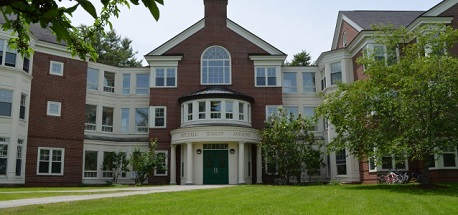Bates College and Colby College are just 48 miles apart. Both are private institutions and the admission process for both is fairly competitive. So, which is the better choice?
The two schools have a lot in common. Even the tuition rates at the two colleges are almost identical.
Both institutions are home to about 1,800 students, but each campus does have a distinct flavor of its own. Colby is located in rural Maine, and the campus covers a sprawling 714 acres, much of which is a protected State Wildlife Management Area. Bates, located in Lewiston proper, has a distinctly small-town urban feel, and its facilities occupy just 109 acres of land.
There are so many similarities between both of these selective colleges that it’s easy for them to start looking the same. But with a bit of feedback from students themselves and a little deeper digging into each university’s personality, each college’s unique personality comes through a little more clearly.
Academics
Statistically, there’s not a lot to set these Bates and Colby apart academically; both boast small class sizes and a low instructor-to-student ratio, so we asked students what they thought of the academic life at each school.
Though both colleges are fairly selective during the admissions process, only 12% of Bates College students and 8% of Colby students said they consider the academic atmosphere to be “highly competitive.” Another 16% of Bates students categorized their school’s academics as “competitive,” compared to an even higher 24% at Colby.
Students from both colleges said they thought their schools were more collaborative overall. 52% of Bates students and 44% of Colby students said the atmosphere fell into that “collaborative” category. Overall, both schools prize collaboration and teamwork, though more students ranked Bates somewhere along the collaborative spectrum than did students from Colby.
How academically intense are the classes themselves? The amount of time students spend studying is an indicator, and the majority of both Bates and Colby students said they spent about 3-4 hours each day with their books. 40% of Bates students said they study for 5 hours or more each day, compared to only 24% of Colby College students.
36% of Bates students said their academic load was manageable, compared to only 32% of Colby students; overall, students rate Bates as the more academically rigorous of the two colleges, though neither could be classified as easy.
Faculty
In the midst of the academic atmosphere, the instructors usually make all the difference between students who love their school and students who can’t wait to get out. “I love all the opportunities at Bates and the close knit community,” a Bates junior said. “The professors are usually very helpful and want you to succeed. Small class sizes allow you to really get to know your professors.”
Bates students consistently give the faculty and staff high marks. The friendly, supportive environment makes a big difference in their satisfaction, students say. About 46% of Bates students said they talk to professors about class-related subjects on a weekly basis; 60% of Colby students, though, said they converse with their professors about classroom topics on a monthly basis or less often.
Colby students also spoke highly of their academic advisers; only 4% said they were not satisfied with their experience with their adviser, while 72% said they were either “very satisfied” or “somewhat satisfied.” 92% of Bates students said they were satisfied with their advisers, reflecting their higher levels of satisfaction with the atmosphere and academics of their school.
That doesn’t mean many Colby students don’t have fantastic experiences, though. “My adviser has been my savior in my first year of school,” said a Colby College sophomore. “I wouldn’t have found my major or been confident with my course choices without her. She has been my biggest advocate.”
Campus Life
At Bates College, 92% of students live on campus, mostly in coed dorms. 77% of Colby students live in coed dorms, while 15% live in apartments for single students. 88% of Bates students and 92% of Colby students said they were satisfied with their on-campus housing.
Students at Colby often complained about the cliquish nature of many of their peers. 56% of Colby students said cliques are prevalent on campus, though they don’t play a huge role in the life of the school; 48% of Bates students reported the same. 32% of students at both schools said cliques play a big role in their college’s social life.
Bates students, however, commented on how welcoming both students and professors were, highlighting the incredibly friendly and supportive environment.“Everyone you meet is extremely friendly – no matter where you go, you will always be greeted with a smile,” said one Bates junior.
On the other hand, some Colby students wished for more social opportunities and ways to get involved in the community: “I love academic life here but there could be more done to improve the social aspects of school, especially weekend activities,” said a Colby sophomore.
Social Life
Some Colby students complained of the prevalence of the drinking culture on campus; at times, it seemed that “social life” got in the way of academics and other activities. 92% of students said drinking was a very important part of the school life, part of most campus activities, compared to only 79% of Bates students.
The social pressure to drink is very real at both schools, as well; 13% of Bates students said you’d stand out if you didn’t drink, compared to 8% of students at Colby.
“The drinking culture on campus is a little more prevalent than I would like, but at the same time I don’t really feel like I stick out because I don’t drink; I’ve definitely still been able to make friends and get involved in things,” one Colby freshman said.
Bates students had less to say about the cliques and alcohol on campus, though they did say they wished the Lewiston area had more to offer area students. 50% of Bates students and 68% of Colby students said that the school’s relationship to the local community was “somewhat close.”
“I wish the Lewiston-Auburn area was more attractive for students. Currently, somewhat of a disparity exists between the locals and students,” said a Bates junior. Students from both schools said that their social life happened mostly on-campus, including 71% of Bates students and 80% of Colby students.

Bates College Pond
Student Satisfaction
One of the top indicators of student satisfaction is a school’s retention rates: how many freshmen return after their first year, and how many students stick around until graduation? The four-year-graduation rate is barely higher at Colby than at Bates; 86% of freshmen graduate within four years at Colby, compared to 85% at Bates.
71% of students surveyed from both schools said they would definitely recommend their college to prospective students, an impressive and encouraging statistic.
All in all, it’s tough to decide on a college to attend based on statistics–or even on one visit to campus. The best way to find out whether Bates or Colby is the right fit for you is to ask current students and get a variety of perspectives before you get started.




